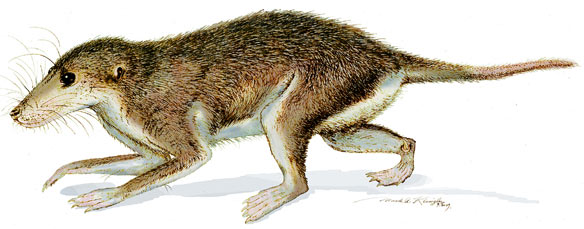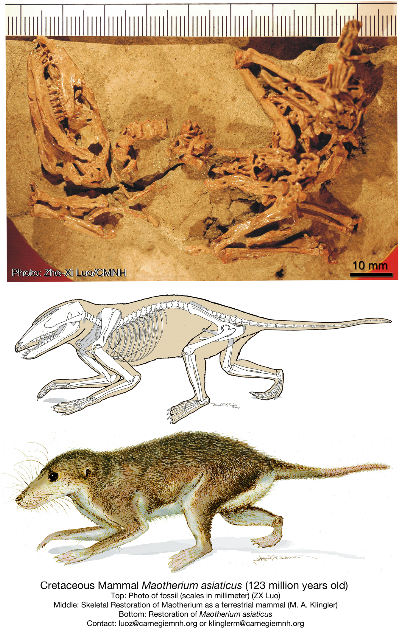
Maotherium asiaticus
Illustration by Mark A. Klingler/Carnegie Museum of Natural History.
October 9, 2009

Maotherium asiaticus
Illustration by Mark A. Klingler/Carnegie Museum of Natural History.
Paleontologists in the U.S. and China have discovered a new species of mammal that lived 123 million years ago in what is now the Liaoning Province in China. The newly discovered chipmunk-sized animal, named Maotherium asiaticus, was found in the famous fossil-rich beds of the Yixian Formation in China.
The fossil mammal, reported in this week’s issue of the journal Science, offers an important clue to how the mammalian middle ear evolved. It represents an intermediate stage in the evolutionary process of how modern mammals acquired a middle ear structure.
Hearing is an important sensory function for humans, whether for listening to an interesting conversation or to beautiful music, says Zhe-Xi Luo, a paleontologist at the Carnegie Museum of Natural History in Pittsburgh, Pa., and an author of the Science paper. For mammals as a whole, Luo says, hearing is an evolutionary adaptation vital for survival.
“With a tiny and intricate middle ear structure, mammals have more sensitive hearing in a wider range of sounds than other vertebrates,” says H. Richard Lane, program director in the National Science Foundation (NSF)’s Division of Earth Sciences. “This sensitive hearing was crucial for mammals to develop nocturnal adaptations and to survive in dinosaur-dominated times.”
The newly discovered ground-living mammal, some five inches long, had teeth with symmetrically arranged cusps specialized for feeding on insects and worms.
By studying this exquisitely preserved fossil, Luo and colleagues believe Maotherium is closely related to marsupials and placentals.
“What is most surprising, and thus scientifically interesting, is this animal’s ear,” study co-author Zhe-Xi Luo of the Carnegie Museum of Natural History said in a statement.
Mammals have highly sensitive hearing, far better than the hearing capacity of all other vertebrates. According to the Chinese and American scientists who discovered the new mammal, the middle ear bones of Maotherium are similar to those of modern mammals.
But unlike modern mammals, Maotherium’s middle ear has an unusual connection to its lower jaw.
This connection, also known as the ossified Meckel’s cartilage, resembles the embryonic condition of living mammals and the primitive middle ear of pre-mammalian ancestors. These mammal middle ear bones evolved from the bones of the jaw hinge in reptilian relatives.
Paleontologists have long tried to understand the evolutionary pathway through which these precursor jaw-bones became separated from the jaw and moved into the middle ears of modern mammals.
Maotherium asiaticus is a beautifully preserved fossil, one that made it possible for us to reconstruct how the middle ear could be attached to the jaw, says Luo.
Modern biology has shown that genes can trigger the development of unusual middle ear structures like the “re-appearance” of the Meckel’s cartilage in modern mice.
The scientists suggest that the unusual middle ear structure found in the Chinese fossil, such as the ossified Meckel’s cartilage, is the manifestation of developmental gene mutations in long-ago mammal evolution.
The Science paper is co-authored by paleontologists Qiang Ji of the Chinese Academy of Geological Sciences in Beijing and Xinliang Zhang of the Henan Provincial Geological Museum, along with other collaborators.
The researchers also received support from the National Natural Science Foundation (China), Ministry of Science and Technology (China), and National Geographic Society.

_________________________________
For more on the opening soon, see International Cryptozoology Museum.
About Loren Coleman
Loren Coleman is one of the world’s leading cryptozoologists, some say “the” leading living cryptozoologist. Certainly, he is acknowledged as the current living American researcher and writer who has most popularized cryptozoology in the late 20th and early 21st centuries.
Starting his fieldwork and investigations in 1960, after traveling and trekking extensively in pursuit of cryptozoological mysteries, Coleman began writing to share his experiences in 1969. An honorary member of Ivan T. Sanderson’s Society for the Investigation of the Unexplained in the 1970s, Coleman has been bestowed with similar honorary memberships of the North Idaho College Cryptozoology Club in 1983, and in subsequent years, that of the British Columbia Scientific Cryptozoology Club, CryptoSafari International, and other international organizations. He was also a Life Member and Benefactor of the International Society of Cryptozoology (now-defunct).
Loren Coleman’s daily blog, as a member of the Cryptomundo Team, served as an ongoing avenue of communication for the ever-growing body of cryptozoo news from 2005 through 2013. He returned as an infrequent contributor beginning Halloween week of 2015.
Coleman is the founder in 2003, and current director of the International Cryptozoology Museum in Portland, Maine.
Filed under Breaking News, CryptoZoo News, Fossil Finds